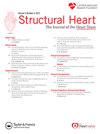Feasibility, Efficacy, and Safety of the Mitral Annulo-TRIpsy in eXtreme Risk Patients
IF 2.8
Q3 CARDIAC & CARDIOVASCULAR SYSTEMS
引用次数: 0
Abstract
Background
Severe calcific mitral stenosis is common and therapeutically challenging. Intravascular lithotripsy (IVL) can facilitate percutaneous balloon mitral valvuloplasty in patients not amenable to conventional therapies. We describe a modified technique using larger IVL balloons to ensure maximal annular contact and delivery of ultrasonic shockwaves to restore mitral leaflet pliability and reduce transvalvular gradients without the need for noncompliant valvuloplasty balloons.
Methods
Seven patients underwent the Mitral Annulo-TRIpsy in eXtreme risk patients (MATRIX) procedure at 3 tertiary structural heart disease centers in the United States. Transcatheter mitral valve replacement was contraindicated due to prohibitive risk of left ventricular outflow tract obstruction or insufficient annular calcification for anchoring of a balloon-expandable valve. IVL balloons were delivered using a large-bore transseptal sheath over three 0.014 wires. Runs of delivery of IVL therapy were repeated until satisfactory results in terms of mean mitral gradient (mMG) reduction were achieved.
Results
Median age was 78 years, and 14.3% were female. All patients presented with progressive New York Heart Association class III-IV symptoms and functional limitations. Pre-MATRIX mMG was 9.0 mmHg. The final mMG was 3.0 mmHg (absolute difference 6.3 mmHg; 95% CI 2.6-10.1 mmHg; p <0.01). No conventional valvuloplasty balloons were used after IVL. All patients successfully underwent MATRIX. No major periprocedural complications were observed including death, stroke, major bleeding, or reintervention. No patients experienced worsening mitral regurgitation. All patients were discharged alive.
Conclusions
This small multicenter series demonstrates that IVL of calcified mitral stenosis using the MATRIX technique is feasible and safe and associated with effective reductions in mMG.
二尖瓣环治疗极端危险患者的可行性、有效性和安全性
背景:严重的钙化性二尖瓣狭窄是常见的,治疗上具有挑战性。血管内碎石术(IVL)可以促进经皮球囊二尖瓣成形术患者不适合常规治疗。我们描述了一种改进的技术,使用更大的IVL球囊来确保最大的环接触和超声冲击波的传递,以恢复二尖瓣小叶的柔韧性和减少跨瓣梯度,而不需要不符合的瓣膜成形术球囊。方法在美国3个三级结构性心脏病中心,7例患者接受了极端危险患者(MATRIX)二尖瓣环术。经导管二尖瓣置换术是禁忌的,因为左心室流出道梗阻或球囊膨胀性瓣膜锚定不充分的环形钙化。IVL气球通过三根0.014金属丝通过大口径跨隔膜鞘输送。IVL治疗反复进行,直到在平均二尖瓣梯度(mMG)降低方面取得满意的结果。结果中位年龄为78岁,女性占14.3%。所有患者均表现为进行性纽约心脏协会III-IV级症状和功能限制。Pre-MATRIX mMG为9.0 mmHg。最终mMG为3.0 mmHg(绝对差6.3 mmHg; 95% CI 2.6-10.1 mmHg; p <0.01)。IVL后未使用常规瓣膜成形术球囊。所有患者均成功接受MATRIX治疗。未观察到重大围手术期并发症,包括死亡、卒中、大出血或再干预。没有患者出现二尖瓣返流恶化。所有患者出院时均存活。结论这个小的多中心研究表明,使用MATRIX技术进行钙化二尖瓣狭窄的IVL是可行和安全的,并且与mMG的有效降低有关。
本文章由计算机程序翻译,如有差异,请以英文原文为准。
求助全文
约1分钟内获得全文
求助全文
来源期刊

Structural Heart
Medicine-Cardiology and Cardiovascular Medicine
CiteScore
1.60
自引率
0.00%
发文量
81
 求助内容:
求助内容: 应助结果提醒方式:
应助结果提醒方式:


